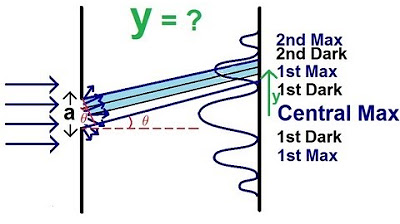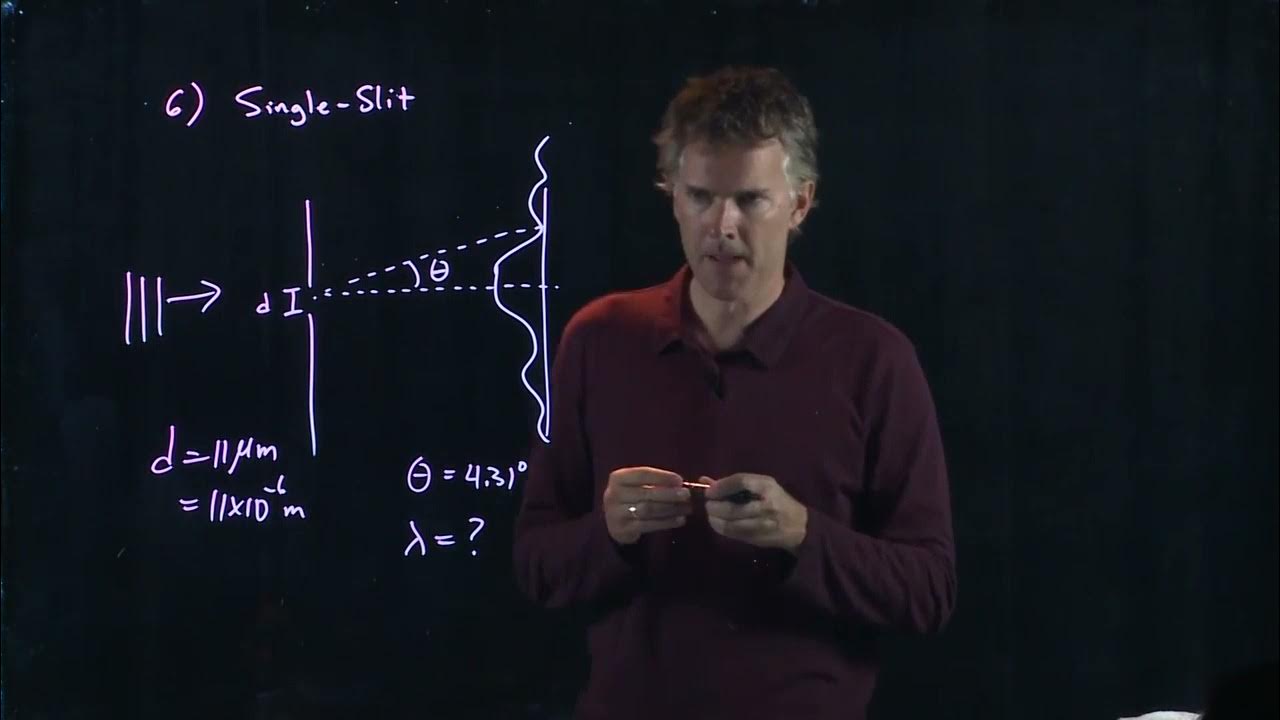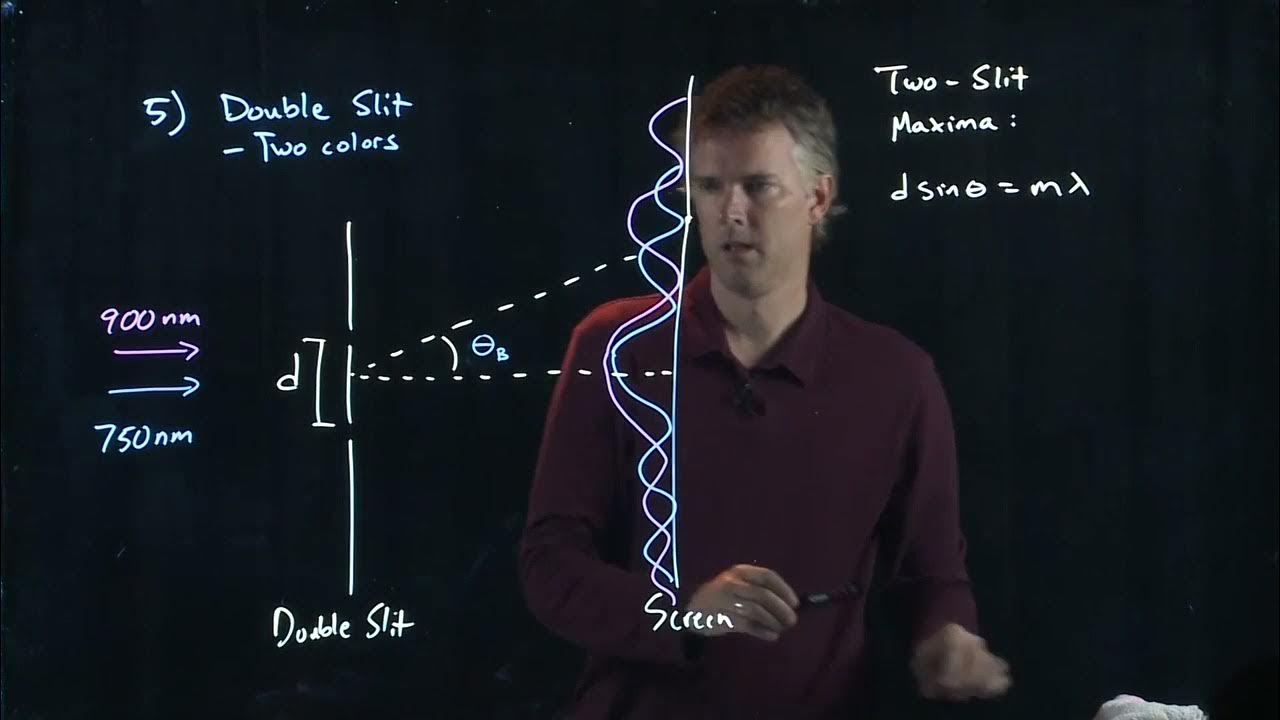Single Slit Diffraction | Physics with Professor Matt Anderson | M28-16
TLDRThe script discusses a single-slit diffraction problem, illustrating how the width of the central bright spot on a distant screen changes with the slit width. It explains that when the slit is very small, the diffraction pattern expands more, contrary to intuition. The concept that a smaller hole results in a wider spread is highlighted, emphasizing the peculiar nature of diffraction.
Takeaways
- 🔬 The script discusses a single-slit diffraction problem involving light waves passing through a slit and forming a pattern on a distant screen.
- 📏 It is assumed that the angles involved in the diffraction are small, which simplifies the analysis.
- 🌀 The central bright spot on the screen is a key feature of the diffraction pattern, and the script asks how its width changes with the slit width.
- 🔍 The width of the central bright spot is related to the size of the slit; doubling the slit width will affect this width.
- 📉 If the slit width is reduced, the diffraction pattern will be more 'squished' together, indicating a narrower spread of light.
- 📈 Conversely, increasing the slit width will cause the diffraction pattern to spread out more, making the pattern wider.
- 🌌 The script highlights the counterintuitive nature of diffraction: smaller slits result in a wider spread of light.
- 📚 The dark spots in the diffraction pattern are mentioned, which are related to the angle θ relative to the optic axis.
- 🤔 The script suggests thinking about the problem conceptually before diving into equations, which can help in understanding the underlying physics.
- 👤 There is a humorous moment in the script where the speaker playfully calls out 'Joe' for not paying attention, adding a light-hearted tone to the explanation.
- 📝 The script implies that understanding the basic principles of diffraction can help in predicting the effects of changing the slit width without needing to calculate exact angles or patterns.
Q & A
What is the topic of discussion in the script?
-The script discusses a single-slit diffraction problem in optics.
What is a single-slit diffraction pattern?
-A single-slit diffraction pattern is a pattern of light and dark bands that forms on a screen when a plane wave passes through a narrow slit.
What is the assumption made about the angles in the problem?
-The script assumes that the angles involved in the diffraction pattern are small.
What is the effect of doubling the slit width on the central bright spot?
-The width of the central bright spot on the screen will change based on the slit width being doubled.
What is the relationship between the size of the slit and the spread of the diffraction pattern?
-A smaller slit results in a more spread out diffraction pattern, while a larger slit results in a less spread out pattern.
Why does a smaller slit cause the light to spread out more?
-A smaller slit causes more pronounced diffraction, which leads to a wider spread of the light waves and thus a more expanded diffraction pattern.
What is the significance of the interference from the edges of the slit?
-The interference from the edges of the slit contributes to the formation of the diffraction pattern, including the bright and dark spots.
What is the term for the angle of the dark spot relative to the optic axis?
-The angle of the dark spot relative to the optic axis is referred to as theta (θ).
Can the change in the width of the central bright spot be understood without equations?
-Yes, the script suggests that one can make sense of the change in the width of the central bright spot by considering the effect of the slit size on the spread of the diffraction pattern.
What is the role of the optic axis in the diffraction pattern?
-The optic axis is the reference line from which the angles of the diffraction pattern, such as the angle of the dark spot, are measured.
How does the script use an analogy to explain the diffraction pattern change with slit width?
-The script uses the analogy of a very small hole compared to a larger one to explain that a smaller hole results in a more expanded diffraction pattern due to increased spreading of light.
Outlines
🔬 Single Slit Diffraction Pattern Analysis
This paragraph discusses a single slit diffraction problem, explaining how the width of the central bright spot on a distant screen changes when the slit width is doubled. It introduces the concept of diffraction through a hole in a screen and the resulting pattern due to interference from the edges. The speaker uses a thought experiment comparing the diffraction patterns of a very small hole versus a larger one, highlighting the counterintuitive nature of diffraction where a smaller hole results in a more spread out pattern.
Mindmap
Keywords
💡Single Slit Diffraction
💡Distant Screen
💡Central Bright Spot
💡Slit Width
💡Plane Wave
💡Interference
💡Dark Spot
💡Optic Axis
💡Diffraction Pattern
💡Spread Out
💡Wave Optics
Highlights
Introduction to a single slit diffraction problem.
Formation of a single slit diffraction pattern on a distant screen.
Assumption of small angles in the diffraction pattern analysis.
Inquiry into the effect of doubling the slit width on the central bright spot's width.
Description of a plane wave passing through a single slit.
Explanation of interference from the edges of the slit.
Illustration of the resultant diffraction pattern.
Discussion of the equations related to the dark spot in the pattern.
Introduction of the angle theta relative to the optic axis.
Suggestion to understand the problem without equations.
Experimentation with a very small hole for the slit.
Observation that a smaller slit results in a more expanded diffraction pattern.
Contrasting behavior of diffraction through small versus large holes.
Conclusion that a larger slit results in less spreading of the diffraction pattern.
Misdirection with Joe's attention, followed by a prompt to focus.
Final observation of the diffraction pattern becoming wider with a larger slit.
Transcripts
Browse More Related Video

Physics - Diffraction of Light (1 of 4) The Thin Slit

Single Slit Interference | Physics with Professor Matt Anderson | M28-19

Light Is Waves: Crash Course Physics #39

Solving the HARDEST Oxford Physics Admission Question from 2021?

Two Slit Interference | Physics with Professor Matt Anderson | M28-18

Interference Patterns
5.0 / 5 (0 votes)
Thanks for rating: